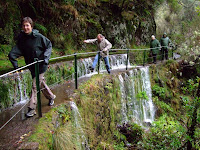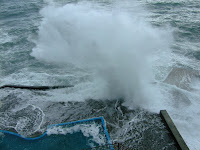 The weather pundits' pessimistic prediction pertaining to today was a 95% probability of precipitation which precluded our participation in the programme previously planned for the day. So, instead of visiting some gardens further a field with the option of a levada walk, we remained closer to home and followed a tour around the city centre to look at some of the architecture and three churches. The contrast between the lavish interior of the Jesuit church and the plain interior of the circular English church could not be more marked.
The weather pundits' pessimistic prediction pertaining to today was a 95% probability of precipitation which precluded our participation in the programme previously planned for the day. So, instead of visiting some gardens further a field with the option of a levada walk, we remained closer to home and followed a tour around the city centre to look at some of the architecture and three churches. The contrast between the lavish interior of the Jesuit church and the plain interior of the circular English church could not be more marked.Along the way we called in to see the Old Blandy Wine Lodge,
 a tourist trap built in one of the original wine premises in Funchal. If your pockets are deep enough you can purchase Madeiran fortified wine bottled in the late 19th century. We did not pay for the tour so did not see the vintages from those years but there were plenty of bottles on display that were as old as us; we did not bother enquiring what the price was.
a tourist trap built in one of the original wine premises in Funchal. If your pockets are deep enough you can purchase Madeiran fortified wine bottled in the late 19th century. We did not pay for the tour so did not see the vintages from those years but there were plenty of bottles on display that were as old as us; we did not bother enquiring what the price was. In the Town Hall we came across a display of nativity scenes that were clearly the results of a competition to make a nativity scene from recycled or waste material; there were some most creative results.
In the Town Hall we came across a display of nativity scenes that were clearly the results of a competition to make a nativity scene from recycled or waste material; there were some most creative results.We revisited the markets to see them as they should be and got suckered into buying an exorbitantly
 expensive selection of different flavoured passion fruit. There were seven in the bag, none of which looked like the passion fruit we are used to in NZ. According to the vendor the bag contained one each of lemon, peach, banana, tomato, pineapple and two we could not remember but although they looked quite different the taste was fairly uniform: at a bit over €10 we were well and truly 'had'. The 'tomato' one turned out to be a common old tamarillo that are a dime-a-dozen in NZ.
expensive selection of different flavoured passion fruit. There were seven in the bag, none of which looked like the passion fruit we are used to in NZ. According to the vendor the bag contained one each of lemon, peach, banana, tomato, pineapple and two we could not remember but although they looked quite different the taste was fairly uniform: at a bit over €10 we were well and truly 'had'. The 'tomato' one turned out to be a common old tamarillo that are a dime-a-dozen in NZ. The next disappointment was the Boa Vista Orchid garden. Recommended in the guidebooks and supposedly in the middle of the flowering season, the €4.50 entry was about €3 over what it was worth for a walk around the muddy paths inside some run-down orchid houses with a few blooms on show.
The next disappointment was the Boa Vista Orchid garden. Recommended in the guidebooks and supposedly in the middle of the flowering season, the €4.50 entry was about €3 over what it was worth for a walk around the muddy paths inside some run-down orchid houses with a few blooms on show.









































